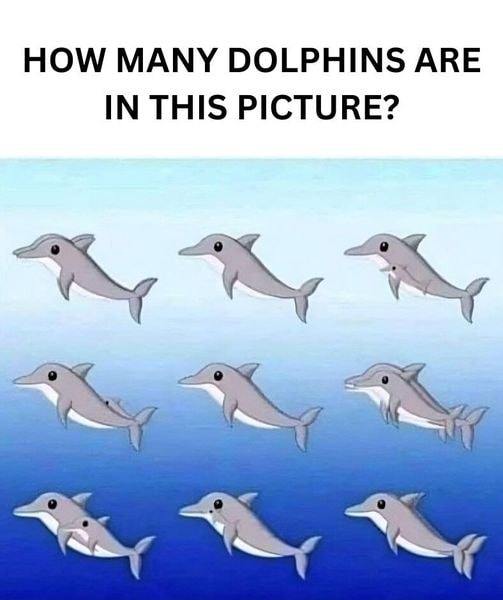Brain teasers and optical illusions are entertaining ways to deceive others and maintain mental acuity. When they view a picture that causes them to double take, most individuals feel compelled to look at what they may have seen again. Adorable dolphins appear in this brainteaser, which is sure to stump the intellect.

What is the number of dolphins in the image? There are surprisingly seventeen dolphins. While some are more covertly hidden, others are hidden in plain sight. Certain ones blend in with one another. With five dolphins in the first row. Six are included in both the second and third rows.

There don’t appear to be many dolphins at first look. But after a little while, the brain and sight begin to recognize more tiny dolphins, until finally 17 are visible. It’s interesting to note, though, that it’s very usual for people to overlook many dolphins at first glance. You may still attempt other ones even if you didn’t make it on that one.
Try Another Excerpt
For instance, this stunning photograph appears to have few tigers at first sight.

In actuality, there are sixteen tigers in all.

Maybe some tigers escaped your notice. Try using squares once more!

You guessed correctly when you said 40! It’s interesting that this brainteaser was posted on WhatsApp, an app that has a few more benefits in addition to being well-known for connecting people across borders. One is the assortment of puzzles and brainteasers that users can attempt or challenge one another with.
The Workings of Optical Illusions
When faced with an optical illusion or brain teaser, most individuals feel like they’ve been knocked down a peg or two, and with good reason. It turns out that these puzzles do more than just keep our thoughts active and sharp. As a result, they’re made to deceive us, making it tougher for our brains to interpret the image. “What you actually see when you look at something is the light that entered your eye after bouncing off of it, which then transforms the light into electrical impulses that your brain can process to create an image you can use.” As stated by Inside Science.
It takes a tenth of a second, but within that time, your eyes are constantly receiving a flood of light and a staggering quantity of information, making it extremely difficult for your brain to try to focus on everything at once. It would be similar to attempting to drink from a fire hose. To help you focus on what’s essential, your brain simplifies what it sees and takes shortcuts. Optical illusions exploit these sorts of shortcuts to deceive our minds.
Comparable but Distinct
While both brain teasers and optical illusions aim to deceive or exercise the mind, they are not quite the same. They differ in a few significant ways. A brain teaser, on the other hand, requires you to use logic and thinking to solve the problem. For instance, optical illusions are typically graphic puzzles that conceal something in the image, forcing the participant to slow down and focus on all the little details.
In any case, both are excellent resources for maintaining mental acuity. They’re also a playful and entertaining technique to fool others around us.
